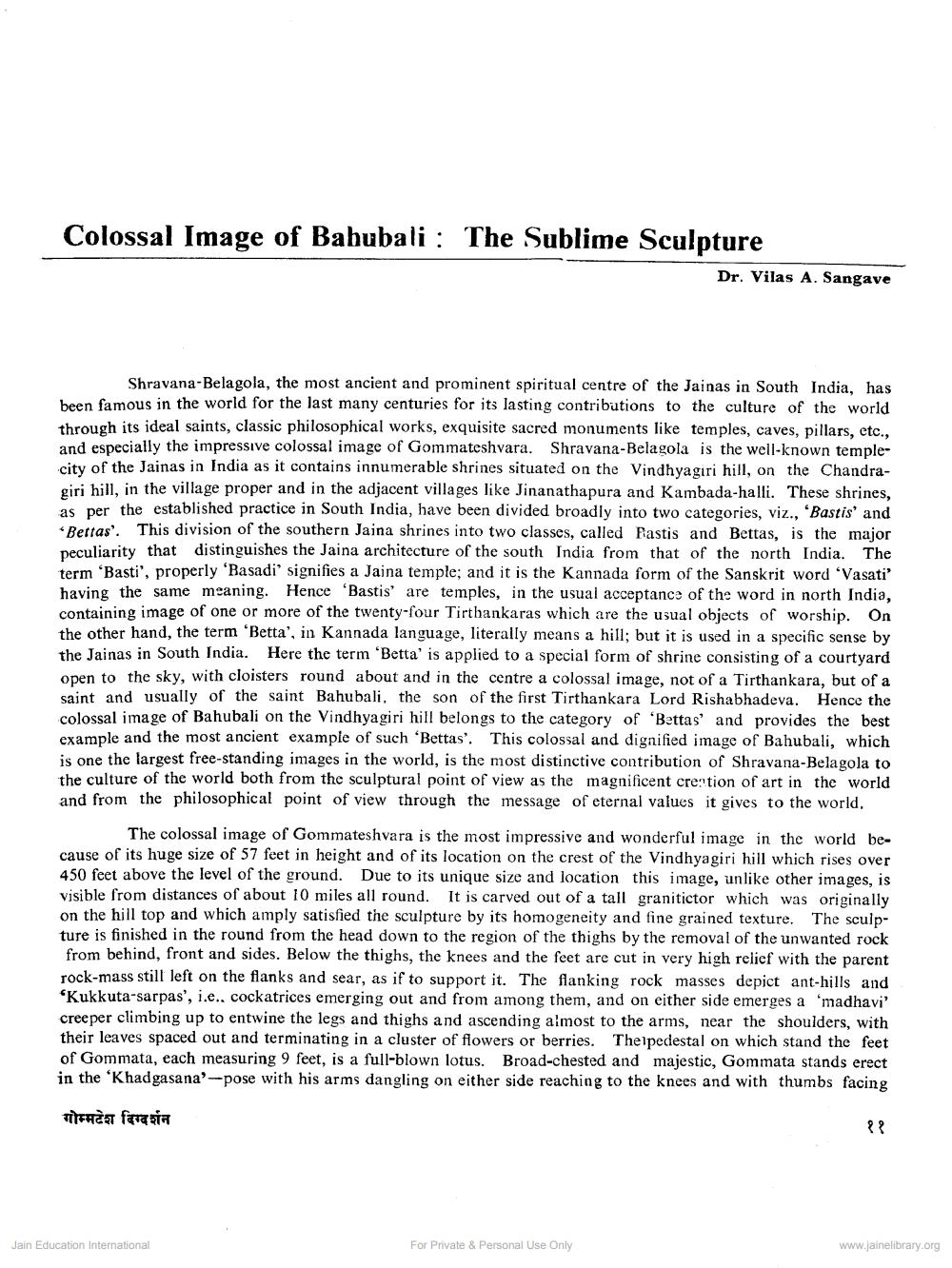________________
Colossal Image of Bahubali: The Sublime Sculpture
Shravana-Belagola, the most ancient and prominent spiritual centre of the Jainas in South India, has been famous in the world for the last many centuries for its lasting contributions to the culture of the world through its ideal saints, classic philosophical works, exquisite sacred monuments like temples, caves, pillars, etc., and especially the impressive colossal image of Gommateshvara. Shravana-Belagola is the well-known templecity of the Jainas in India as it contains innumerable shrines situated on the Vindhyagiri hill, on the Chandragiri hill, in the village proper and in the adjacent villages like Jinanathapura and Kambada-halli. These shrines, as per the established practice in South India, have been divided broadly into two categories, viz., 'Bastis' and "Bettas'. This division of the southern Jaina shrines into two classes, called Fastis and Bettas, is the major peculiarity that distinguishes the Jaina architecture of the south India from that of the north India. The term 'Basti', properly 'Basadi' signifies a Jaina temple; and it is the Kannada form of the Sanskrit word 'Vasati' having the same meaning. Hence 'Bastis' are temples, in the usual acceptance of the word in north India, containing image of one or more of the twenty-four Tirthankaras which are the usual objects of worship. On the other hand, the term 'Betta', in Kannada language, literally means a hill; but it is used in a specific sense by the Jainas in South India. Here the term 'Betta' is applied to a special form of shrine consisting of a courtyard open to the sky, with cloisters round about and in the centre a colossal image, not of a Tirthankara, but of a saint and usually of the saint Bahubali, the son of the first Tirthankara Lord Rishabhadeva. Hence the colossal image of Bahubali on the Vindhyagiri hill belongs to the category of 'Bettas' and provides the best example and the most ancient example of such 'Bettas'. This colossal and dignified image of Bahubali, which is one the largest free-standing images in the world, is the most distinctive contribution of Shravana-Belagola to the culture of the world both from the sculptural point of view as the magnificent creation of art in the world and from the philosophical point of view through the message of eternal values it gives to the world.
Dr. Vilas A. Sangave
The colossal image of Gommateshvara is the most impressive and wonderful image in the world because of its huge size of 57 feet in height and of its location on the crest of the Vindhyagiri hill which rises over 450 feet above the level of the ground. Due to its unique size and location this image, unlike other images, is visible from distances of about 10 miles all round. It is carved out of a tall granitictor which was originally on the hill top and which amply satisfied the sculpture by its homogeneity and fine grained texture. The sculpture is finished in the round from the head down to the region of the thighs by the removal of the unwanted rock from behind, front and sides. Below the thighs, the knees and the feet are cut in very high relief with the parent rock-mass still left on the flanks and sear, as if to support it. The flanking rock masses depict ant-hills and 'Kukkuta-sarpas', i.e.. cockatrices emerging out and from among them, and on either side emerges a 'madhavi' creeper climbing up to entwine the legs and thighs and ascending almost to the arms, near the shoulders, with their leaves spaced out and terminating in a cluster of flowers or berries. Thelpedestal on which stand the feet of Gommata, each measuring 9 feet, is a full-blown lotus. Broad-chested and majestic, Gommata stands erect in the 'Khadgasana'-pose with his arms dangling on either side reaching to the knees and with thumbs facing
११
गोम्मटेश दिग्दर्शन
Jain Education International
For Private & Personal Use Only
www.jainelibrary.org




